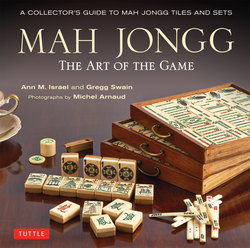Читать книгу Mah Jongg: The Art of the Game - Gregg Swain - Страница 8
Оглавление| CHAPTER 1 A Brief History of Mah Jongg |
Mah Jongg is not the ancient game some people believe it to be. Evidence places the origin of the game squarely in China in the early to mid-19th century. At this time, the game was not called Mah Jongg. The earliest name we know of was “Beating the Sparrow.” Later, the game had two more common names, “Ten Points” and “Sparrows.” To Western ears, the Chinese regional dialects of the name “Sparrows” may have sounded like “Mah Jongg.”
Mah Jongg is basically a card game played with tiles instead of cards. The suits on the tiles closely resemble those found on a deck of cards.
The early tile set suits were taken from a late 18th to early 19th-century Chinese deck of cards using money symbols. The three suits were called Cash, Strings of Cash, and Myriads of Cash.
Joseph P. Babcock, an American businessman who was working for an oil company in China, became fascinated with the game. He was an entrepreneur who seized an opportunity to develop and export the game to the West. He claimed he was responsible for naming the modern Mah Jongg suits, probably based on the inscriptions on the tiles.
Although the pictures on the cards were detailed, their designs became streamlined and more abstract by carving them on hard bone. To the Western eye, two of the suits may have looked like circles and bamboo rods. So Cash became Circles, Strings of Cash became Bamboo Rods or Bamboo, and Myriads of Cash became Characters or Craks.
The Winds/Directions tiles can be seen at the earliest in three sets from the 1870s. They also had many additional “Jokers” (Flowers and Kings tiles). The three dragons made their first appearance in the next early set, collected in 1889. But the Flowers and Kings that had served as Jokers in these earlier sets were no longer included.
Wealthy Chinese women playing Mah Jongg towards the end of the last Imperial dynasty in China, c. 1912.
It is not until Stewart Culin’s set from 1910 (now in the Brooklyn Museum) that we have what looks basically like our Western tile set, with the three Dragons plus the Flowers and Seasons. By then the Red and Green Dragons were also being shown in other sets using the Chinese characters “Dragon” and “Phoenix.” It was tile sets with the Culin set combination (three suits and Dragons, Flowers, and Seasons) that Joseph Babcock began exporting to the West in 1920. From then on, Mah Jongg became a huge craze.
Clockwise from top Close-ups of One Mayfly; One and Two Bams; Six Dot; an unusual Flower with circles and a character; and Three, Eight and Seven Bams. These early concave tiles probably pre-date Babcock’s tile sets.
At one time worldwide demand for the game was so great that bone had to be imported from the US. Photo dated c. 1950.
This bone and bamboo set has One Bam birds with a flower in their mouths, each bird slightly different, and simple rod Bams. Note how detailed the carving is on the One Bams and the Flowers in contrast to the simplicity of the other tiles.
